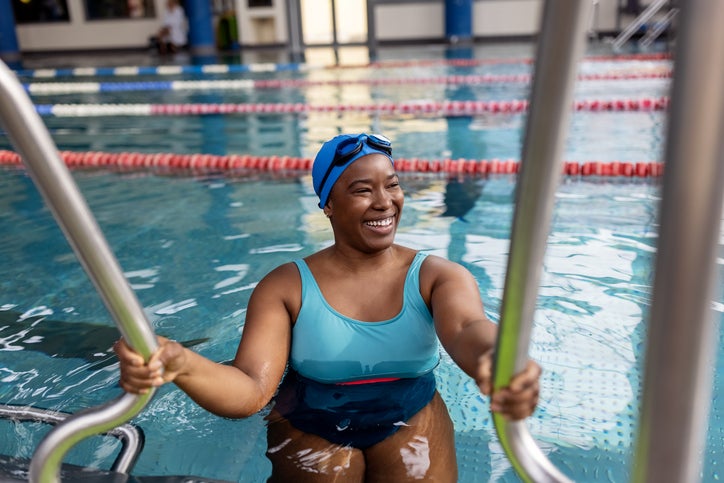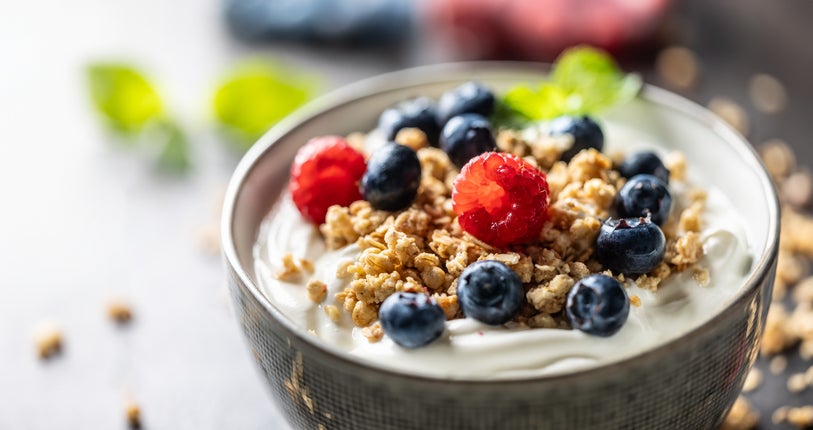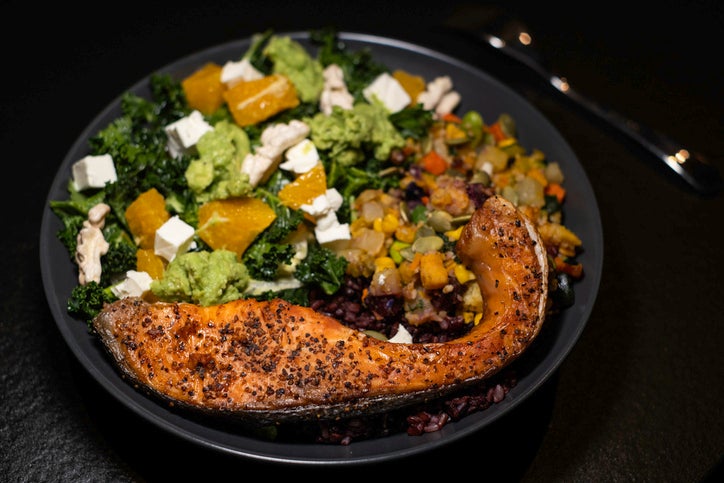Body Positive Weight Loss Tips for Women — with Dietitian Sydney Hinshaw
May 13, 2025By: WakeMed Health & Hospitals
Categories: Women's, diet & nutrition
Tags: women and weight loss, hormones and weight loss, weight loss, eat less move more
Medically reviewed by Sydney Hinshaw, RD
Shedding a few pesky pounds prior to summer is on the minds of many women looking forward to weddings and vacations; summer attire; unforgettable moments captured in photos; and outdoor pursuits, including hiking, biking and swimming. Participating in activities not only aids in calorie burning but also nurtures community and fun. So, what steps can women take to lose weight gained during winter?
With summer almost here, we discussed effective, healthy weight loss with WakeMed dietitian Sydney Hinshaw.
How many calories per day does the average woman need?
A lot of factors, including activity level, height, weight, metabolism and body processes all affect calorie needs. Simply waking, breathing, the heart beating and digesting food require a certain base caloric intake. Dietitians can help women determine their individual needs.
Yet, more important than the number of calories is the quality of food a woman eats. Lower calorie foods are not necessarily better because they could lack nutritional value and fail to support satiety, making a woman hungry sooner, so she ends up consuming even more total calories.
What amount of daily activity would you recommend for the average woman?

Women should aim for 30 minutes of moderate to vigorous activity at least five days per week and an additional two or more days per week of muscle strengthening activities.
Walking the dog for a half hour each day with the dog constantly stopping is not vigorous enough. While these walks are good, a consistent, fast-paced activity that gets the heart pumping for at least 30 minutes per session is most desirable.
For women who wish to lose weight, intensity of physical activity is especially important. Various cardio activities, including walking, jogging, running and biking mixed with strength and flexibility can make a big impact in a weight loss regimen.
Ultimately, when considering exercises to incorporate in both weight maintenance and weight loss, choose activities that are enjoyable, and try to incorporate more movement throughout the day, including using a standing desk, taking the stairs, walking during breaks and more.
Do calorie-restricting diets support weight loss in women?
Without a doubt, most restrictive diets make weight loss harder. Women may see results in the beginning, but often this is water weight. If they choose to stick with it, they may end up with weight loss at the cost of vitamin deficiencies or muscle loss.
Moreover, these diets increase cravings for unhealthy foods, and most women, once they stop following the restrictive diet, end up heavier than they were before.
Plus, when the body is not receiving sufficient calories, it goes into a starvation state, which puts the body under stress. Increased inflammation in the body can elevate cortisol levels and disrupt hormonal balance. The results may include a loss of a regular menstrual period along with mental health issues, including anxiety and depression. As well, the body may begin to feed on muscle, leading to the loss of lean muscle mass. When lean muscle mass breaks down, it slows the metabolism. This causes the body to burn fewer calories, resulting in more issues with weight loss down the line.
Restrictive diets also force women to ignore natural hunger cues. Eating is a social, pleasurable activity. When this natural desire is ignored, it can eventually impact the hormones ghrelin and leptin that regulate hunger and appetite.
Many women desire to lose weight for a particular summer event and turn to rapid weight loss diets. What are your thoughts?
Women should avoid rapid weight loss diets because they are restrictive and unsustainable. They can also lead to disordered eating behaviors, such as binge eating. Additionally, as soon as these diets end, women will typically regain the weight they lost and more.
The focus when considering weight loss should be balanced meals and regular physical activity. This combination will pay off in the long run — for those who do not have a preexisting condition or medication regimen affecting weight.
How much weight is safe for someone to lose in one week?
Losing one pound per week is ideal. It is sustainable and typically involves healthy weight loss habits that can be incorporated for a lifetime. Plus, the body adjusts well when weight loss is gradual.
A woman needs to burn 3,500 calories to lose one pound of fat in a week. This amounts to a 500-calorie deficit each day. Exercise can help with this deficit, but it is a large number and weight fluctuates. Hormones and even salt intake can impact weight, so women should not weigh themselves more than once per week and should consider what is going on that could impact weight during that week.
Ultimately, women want to be kind to their bodies and go slowly, so the process of weight loss is a gradual, healthy transition.
Can certain foods combat bloating in women?

Fiber helps tremendously with bloating. It assists women in digestion, aiding in more regular bowel movements. Fiber is available in fruits, vegetables, whole grains, beans, nuts and seeds. The daily recommendation for women is 25 grams or more.
Water intake is also critical in the fight against bloating. Carbonated beverages, including soda and sparkling water, can increase bloating.
Yogurt has a lot of good probiotics that can help introduce good bacteria into the stomach, decreasing bloating.
Eating more slowly is another helpful method in combatting belly bloat. Oftentimes, women are on the go with lots of responsibilities and eat in a rush. Sitting down, taking time out for the meal and chewing thoroughly — 12 times before swallowing — are important to consider.
Could you provide meal ideas for women?
Women should aim to have protein and fiber each time she eats a meal or snack.
Breakfast
Whole grain bread or toast with peanut butter and banana — The whole grain bread and banana provide the fiber component. Peanut butter would serve as a source of protein and healthy fat.
Snack
Fruit and almonds — Fruit provides fiber, and almonds provide protein. It's also important to aim for a variety of fruits each day. Perhaps one day eat an apple and the next a kiwi. Dried fruit is also fine as long as it does not have added sugar. It's important to read food labels.
Lunch
Salad is a great lunch option — Grilled chicken, or another meat protein, is always preferable to fried. Women can blend in spinach or mixed greens, tomatoes, cucumbers and more. This is also a great meal in which to add healthy fats, such as avocado and dressing. Place dressing on the side so as not to overindulge. Topping a salad with nuts, sunflower seeds or pumpkin seeds also adds a fun crunch and more fiber.

Dinner
Protein, a vegetable and a starch — The goal is simply to have smaller portions at dinner than during earlier meals. I recommend sitting down together as a family for dinner. Try to include fish, such as salmon, at least once per week as it is rich in omega 3s and other healthy fats. The vegetable could include broccoli or another desirable vegetable. For the starch, I prefer sweet potatoes, so we eat quite a bit of those, but women can choose from a variety of healthy starches.
Large Meals
It's better for the metabolism to make the largest meals earlier in the day — breakfast and lunch — to give the body more time to burn calories. Ideally, dinner should be the smallest meal. This is called eating in reverse and is a practical way to maintain weight and even encourage weight loss.
Beverages
The most important beverage of all is water. Sugary drinks, including juices and soda, are often loaded with empty calories that don't lead to satiety, so they are best avoided. And, water doesn't have to be boring. Women can add cucumbers or lemon to it. They can also try flavored water packets.
Dessert
Yogurt and granola or dark chocolate — I, myself, have a sweet tooth and feel strongly as both a dietitian and a human, that it's important not to restrict desirable foods. The goal is to eat them in moderation. When women tell themselves they cannot have something they crave, they long for it even more, and then when they finally get it, they are prone to overindulge. Smaller portions and healthier options are key.
Sources:
- Physical Activity: Adult Activity: An Overview | Physical Activity Basics | CDC
- Caution with Restrictive Diets: 7 Signs You’re Not Eating Enough to Lose Weight | Prevention
- Cortisol Levels: Cortisol: What It Is, Function, Symptoms & Levels
- Bloating: 12 Foods that Help Reduce Bloating